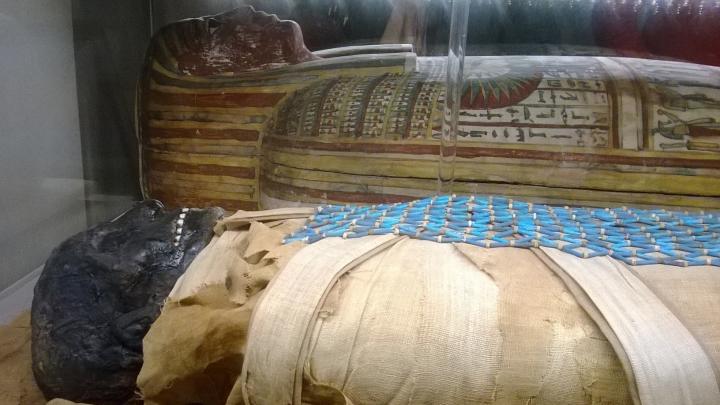For nearly 200 years, the Massachusetts General Hospital (MGH) has housed an unusual patient. Padihershef, one of the first complete Egyptian mummies to reach the United States, arrived in 1823 as a gift from the City of Boston. For well over a century, the mummy and its inner coffin have been on display in the hospital’s original operating room, a background to countless scientific lectures and achievements—most notably, the first public demonstration of surgery under anesthesia in 1846, which has given the amphitheater its present title: the Ether Dome.
Earlier this week, a packed audience in the Ether Dome heard a lecture about Padihershef himself. For the past year, scientists and Egyptologists have collaborated on a conservation project that also employs state-of-the-art x-ray and computed tomography (CT) scans to uncover more about the mummy’s history. Tuesday evening, they summarized the process and their results.
The mummy of Padihershef, found in Thebes, was imported to the United States by Dutch merchant Jacob Van Lennep, said Paul Chapman, Zervas Distinguished Professor of neurosurgery at Harvard Medical School (HMS) and attending surgeon at MGH. As a gift to the young hospital, which admitted its first patient in 1821, Padihershef’s primary purpose was to raise money: in Boston and later Baltimore, spectators paid 25 cents to see what a local newspaper called a “curious relic of Antiquity.” Upon its arrival at MGH, the mummy was briefly examined by surgeon John Collins Warren (then dean of HMS), who unwrapped its head and neck. Detailed academic study, however, has occurred only in the past 50 years, when Egyptologists transcribed the coffin’s hieroglyphics to determine the mummy’s name, age, and former occupation: Padihershef, meaning “gift of the god Hershef,” had been a stonemason during Egypt’s Twenty-Fifth Dynasty, in the early seventh century b.c.e.
The recent conservation, funded in part by an anonymous gift, sought to stabilize the 2,500-year-old specimen and better preserve it for future generations. After decades of being strapped into a damaging upright display (in a 1984 restoration, a broom handle was inserted between the mummy’s body and wrappings to stabilize its head, detached in the 1823 examination), Padihershef now rests horizontally in a new, climate-controlled case. Conservator Mimi Leveque of the Peabody Essex Museum employed a traditional technique using swabs and saliva to remove salts from the body’s surface and restored damaged regions of its wrappings and coffin.
The evening’s newest revelations came from the mummy’s x-ray and CT scans. HMS assistant professor of radiology Rajiv Gupta, who performed the imaging, delivered the medical report, pronouncing the mummy remarkably well preserved. Padihershef had been tall—Gupta estimated five feet, nine inches—and middle-aged at the time of his death, with healthy teeth and bones. The CT scans suggested that brain tissue remains in the skull (unlike many mummies, whose brains were removed after death), but Gupta found no traces of other internal organs, meaning that they were probably either removed or have degraded. The CT scans also provided important data for a forensic facial reconstruction; using 3-D printing, researchers produced an exact reconstruction of Padihershef’s skull. Jonathan Elias, director of the Akhmim Mummy Studies Consortium, then used modern data on tissue thickness at different points of the face to build a clay model of what he might have looked like.
The reconstruction, along with other materials from the conservation project, is on display at the hospital’s Paul S. Russell, MD Museum until the end of February. The mummy itself remains in the publicly accessible Ether Dome, a continuing witness to new scientific developments that may someday reveal yet more about its ancient past.
For more on Padihershef, read a full report by Jonathan Elias.








